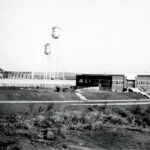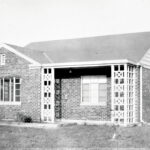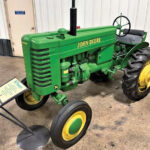Seventy-five years ago on March 12, 1947, the first “M” tractor rolled off the assembly line at the brand new “John Deere Dubuque Works of Deere Manufacturing Co.” By the 28th of March, a pilot run of 50 tractors was completed, and on April 1 the plant shipped the first carload of 10 tractors. The first “M” model, serial number 10001, was shipped west to Company President Charles Deere Wiman, great-grandson of company founder John Deere, to be used on his Arizona ranch.
The actual production of Dubuque’s first “M” tractor came after more than two years of planning and building. Announcement of the construction of a Deere plant in Dubuque was officially made on December 31, 1944. The location was strategically positioned near the Waterloo Tractor Works and the company’s general offices in Moline. Although the announcement said the new factory in Dubuque would produce shell casings for a government contract, tractor making was part of future plans for operation of the factory. Fortunately, World War II ended before Dubuque’s factory was completed, allowing the plant to focus entirely on the production of tractors.
In 1945, the company purchased 740 acres of flat, sandy land along the Mississippi River in Peru Township some three miles north of the City of Dubuque – land that had been the location of a truck farm that produced sweet corn, strawberries, and other produce. Original plans called for a 600,000-square-foot complex with 19 buildings, including a gray-iron foundry that could manufacture tractors, engines, and repair parts. Plans also called for a receiving and storage building; three buildings for machine shop, heat treating, forging, sheet metal stamping, and tool and die; an assembly building; a warehouse and shipping building; a power house with pumps, compressors, boilers, and generators; a service building that would house a medical unit; employment offices; cafeteria; firefighting equipment and garage; and an administration building. Total cost for the ambitious project was estimated to be $9.4 million.
The company hired Philadelphia contractors Day & Zimmerman to build the plant, and grading for the Dubuque factory began on June 25, 1945. By September, the foundation for “D Building” had been poured. Most of the additional structures were built in 1946, and offices officially opened in “J Building” in May of that year. Although the original plan called for just 19 buildings, before they were completed, the company made the decision to expand the footprint an additional 50%. The country’s economy was booming and sales of the popular “M” tractor were far greater than expected.
With construction going forward on schedule, the company began hiring workers for what was then referred to as “The John Deere Dubuque Tractor Company.” Farmers and veterans flocked to the riverside factory from all over the tri-state area. Post-war workers were in great demand, and Deere recruited employees from as far away as Missouri. The job market was volatile, and originally worker turnover was high.
Employees moving to Dubuque soon overwhelmed the local housing market – even apartments became scarce. To address the housing shortage, Deere built a Quonset hut where male employees could live, and a second hut was built nearby to serve as a cafeteria. The company also rented six houses on the factory property for employees and their families. Soon, it became apparent a much larger solution was needed.
Deere responded by forming the Iowa Improvement Company, which eventually built seven duplexes and 97 single-family houses in the Hillcrest Addition on the west side of Dubuque. The “Deereville” houses and duplexes were built on concrete slabs and featured a red brick exterior, steel casement windows, and reliable natural gas heat – the first in Dubuque. The residences offered one-floor living (no basement or garage), two bedrooms, a living room, a kitchen, and a bathroom. A small utility room with furnace and hot water heater was accessed from an exterior door. The average monthly rent came to about $50.
Employees eagerly applied for Deere housing and demand was high. In about 1950, Deere offered employees living in the company-owned houses an option to buy, with previous rent dollars going toward the purchase price. Soon, loyal offspring of Deere employees filled the Deereville neighborhoods, taunting those who dared to drive the streets on any tractor other than a Deere.
Sales of the “M” model tractor were excellent. The small utility tractor was especially popular with farmers, highway departments that used them for mowing, and contractors for use in light construction. The two-cylinder tractor featured hydraulic control and a QUIKTATCH hitch for ease in attaching plows, mowers, and more.
Some 88,000 “M” tractors would roll off the assembly line by end of production in 1952, including variations like the “MI” industrial tractor, the “MT” tricycle version of the model “M,” and the “MC.” The “MC” crawler tractor was introduced in 1949. Many consider the “MC” to be the first true John Deere industrial product, and a forerunner of the extensive yellow line of construction equipment that the John Deere Dubuque Works is noted for to this day.
In 1958, Dubuque’s Deere plant became officially known as the “John Deere Dubuque Works of Deere & Co.” A final name change occurred in 1973, when the plant became known as “John Deere Dubuque Works,” a nod to the factory’s changing focus from agricultural tractors to industrial tractors and machines.
This article is part of the Shades of Dubuque series, sponsored by Trappist Caskets, hand-made and blessed by the monks at New Melleray Abbey. More at trappistcaskets.com.








Comment here